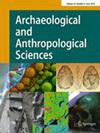Investigating the potential of magnesium isotopes in bioarchaeology: evidence from the Zaoshugounao Site
Abstract
Magnesium, an essential biological element, exhibits stable isotope compositions that reflect organisms' dietary structure and trophic position. Accordingly, magnesium isotope analysis offers valuable potential for reconstructing the ecological niches of modern and ancient mammals within food webs. This study analyzes the magnesium isotope compositions of human and animal enamel samples recovered from the Zaoshugounao site to evaluate the applicability of magnesium isotopes in archaeological research, particularly in differentiating dietary sources, and identify trophic levels. The results demonstrate that the employed purification protocol effectively isolates and quantifies magnesium isotopes in archaeological enamel, preserving a reliable premortem isotopic signal. The analysis reveals significant isotopic differences between herbivores and omnivores, with the latter showing notable enrichment in heavier δ26Mg isotopes. These findings underscore the sensitivity of magnesium isotopes to dietary variation and highlight their potential for reconstructing individual ecological niches. This study provides the first empirical evidence supporting the use of magnesium isotopes for tracing dietary sources and reconstructing trophic levels in archaeological contexts. It introduces a novel isotopic approach to archaeological research and advances our understanding of ancient populations' dietary habits and ecological adaptations.

 求助内容:
求助内容: 应助结果提醒方式:
应助结果提醒方式:


